114 search results - page 17 / 23 » How to Write and Use the Ontology Requirements Specification... |
BMCBI
2006
13 years 7 months ago
2006
Background: As numerous diseases involve errors in signal transduction, modern therapeutics often target proteins involved in cellular signaling. Interpretation of the activity of...
JFP
2007
13 years 7 months ago
2007
Haskell’s popularity has driven the need for ever more expressive type system features, most of which threaten the decidability and practicality of Damas-Milner type inference. ...
ASWEC
1998
IEEE
13 years 11 months ago
1998
IEEE
This paper reports the results from an action research project which studies the benefits of documenting the evolution and the rationale for the evolution of a requirements specif...
IFM
2007
Springer
14 years 1 months ago
2007
Springer
In this paper, we introduce a common semantic framework for developing and formally modeling use cases and task models. Use cases are the notation of choice for functional require...
ICALT
2006
IEEE
14 years 1 months ago
2006
IEEE
The fast development of technologies requires specialized skills that need to be renewed frequently. For example, the semantic web technologies related to knowledge centric organi...


